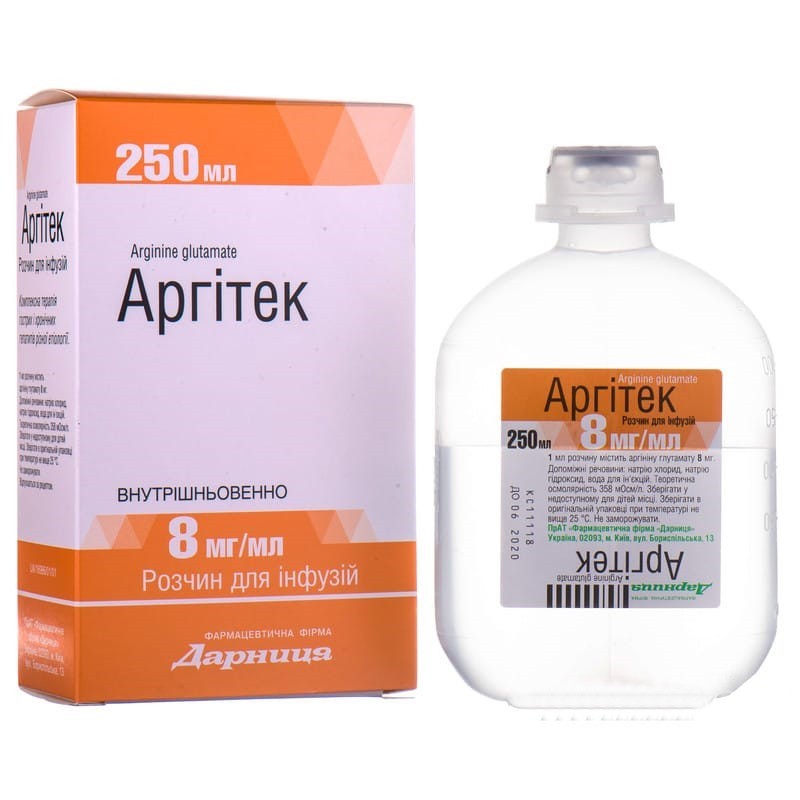



 Secure and encrypted payment processing
Secure and encrypted payment processing We ship to over 40 countries including the USA, UK, Europe, Australia and Japan
We ship to over 40 countries including the USA, UK, Europe, Australia and Japan Guaranteed refund or reship if you haven't received your order
Guaranteed refund or reship if you haven't received your orderActive ingredient: arginine glutamate;
1 ml of solution contains 8 mg arginine glutamate;
excipients: sodium chloride, sodium hydroxide, water for injection.
Solution for infusion.
Basic physical and chemical properties: clear, colorless liquid.
Drugs that are used for liver diseases, lipotropic substances. arginine glutamate. code atx a05v a01.
Pharmacodynamics
Argitec is a compound of arginine and glutamic acid, which play an important role in ensuring biochemical processes of neutralization and excretion of the highly toxic metabolite of the exchange of nitrogenous substances - ammonia. The hypoammonia effects of the drug are realized by activating the neutralization of ammonia in the ornithine cycle of urea synthesis, binding ammonia to non-toxic glutamine, and also enhancing the excretion of ammonia from the central nervous system and its excretion from the body. Thanks to these properties of Argitec, the general toxic, including neurotoxic effects of ammonia are reduced.
Argitec also has a hepatoprotective effect due to its antioxidant, antihypoxic and membrane stabilizing properties, and has a positive effect on the energy supply processes in hepatocytes.
In case of alcohol intoxication, Argitec stimulates the utilization of alcohol in the monooxygenase system of the liver, prevents the inhibition of the key enzyme for the utilization of ethanol - alcohol dehydrogenase; accelerates the inactivation and elimination of toxic products of ethanol metabolism as a result of an increase in the formation and oxidation of succinic acid; reduces the inhibitory effect of alcohol on the central nervous system due to the neurotransmitter properties of exciting glutamic acid. Due to these properties, Argitec exhibits antitoxic and sobering effects.
Argitec does not have embryotoxic, gonadotoxic, mutagenic and teratogenic effects, does not cause allergic and immunotoxic reactions.
Pharmacokinetics
Not investigated.
In the complex treatment of acute and chronic hepatitis of various etiologies, poisoning with hepatotropic poisons (pale grebe, chemicals and drugs), cirrhosis, leptospirosis, hepatic encephalopathy, precoma and coma, accompanied by impaired nitrogen metabolism and hyperammonemia. the state of acute alcohol poisoning of moderate and severe degree, including alcohol encephalopathy and coma, as well as in the complex therapy of post-toxic disorders after acute alcohol poisoning.
Hypersensitivity to the components of the drug, fever, irritability, severe impairment of filtration (nitrogen-excreting) function of the kidneys.
The effect of argitec on insulin secretion increases with the simultaneous use of aminophylline. Argitec may enhance the effect of antiplatelet agents (e.g., dipyridamole). prevents and attenuates neurotoxic effects that may occur with isoniazid. weakens the effect of vinblastine.
When prescribing to patients with impaired endocrine gland function, it should be borne in mind that the drug stimulates the secretion of insulin and growth hormone. Argitec activates the binding of ammonia to urea, which naturally can be accompanied by a short-term increase in its level in the blood.
Excipients.
This medicine contains 0.1 M sodium hydroxide.Caution should be exercised when using it in diet-controlled patients with a controlled sodium content.
The safety of the clinical use of the drug during pregnancy in the i and ii trimesters of pregnancy and during breastfeeding has not been investigated.
Since during treatment, adverse reactions from the central nervous system (headache, dizziness, tremor) can occur, caution should be exercised when driving vehicles or other mechanisms.
The drug is prescribed to adults intravenously.
Introduce intravenously 2 times a day, 1 bottle (2 g) at a rate of 60–70 drops per minute.
In severe cases, increase the daily dose of the drug to 3-4 vials (which corresponds to 6-8 g), divided into 2 injections.
Alcohol poisoning. Intravenously administered drip 2 times a day, 100 ml (0.8 g) at a rate of 60–70 drops per minute.
In severe cases (alcoholic coma), the daily dose is increased to 1 bottle (2 g) 2 times a day.
The maximum daily dose is 8 g. The course of treatment is 5-10 days.
The efficacy and safety of the use of the drug in children has not been investigated.
Symptoms: increased manifestations of adverse reactions, chest pain, atrioventricular block.
Treatment: intravenous administration of corticosteroids. Symptomatic Therapy
Rarely possible:
From the gastrointestinal tract: nausea, pain in the epigastric region.
From the nervous system: headache, dizziness, tremor, weakness.
From the cardiovascular system: atrial fibrillation, decreased blood pressure, tachycardia.
On the part of the immune system: hypersensitivity reactions, including skin rashes, itching, hyperemia, urticaria, angioedema.
General disorders and reactions at the injection site: shortness of breath, pain behind the sternum, fever, chills, changes at the injection site, phlebitis.
1.5 years.
Store in the original packaging at a temperature not exceeding 25 ° C. do not freeze.
Keep out of the reach of children.
250 ml in a bottle; 1 bottle in a pack.
On prescription.
Ciao “Darnitsa pharmaceutical company”.
Ukraine, 02093, Kiev, st. Borispol, 13.